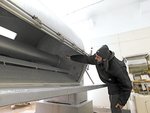



HOPE, Minn. – The employees of Hope Creamery collaboratively decided they would make butter to celebrate over 100 years of being in business; the creamery turned 102 years old Dec. 22, 2021.
“To me it’s an honor,” Mike Iverson said. “Most businesses barely make 100 years old now let alone a business that’s still in the same building.”
Lori Allard agreed.
“It’s a joy to come to work here,” she said. “I think we all feel that.”
Iverson and Allard are two of the few employees who help to make butter every week at Hope Creamery in Hope.
The creamery is owned and operated by Victor and Kellie Mrotz. Other employees are the Mrotzes’ son, Hudson, and Cody Blouin, who also helps to make the butter, four part-time truck drivers, a salesman and an office manager.
The first butter churned out of the creamery was on Dec. 22, 1919.
“Back then, this was a one-stop shop for farmers as farmers could get their fuel, feed and milk processed here,” Iverson said. “They tried to incorporate everything a farmer needs into one entity.”
At the time, the upstairs part of the building was also used for community events, 4-H meetings and a dance hall.
“The building was a modern marvel at the time because it had two stories and indoor plumbing,” Iverson said.
Attracted by the building’s history, local community and the butter, Victor Mrotz knew he had to do something when the creamery was looking at closing in 2001.
“I had grown up on a farm where my parents milked cows until I was about 10 years old,” Mrotz said. “From living in Minneapolis for 16 to 17 years and working as a salesman, I was still getting the paper and read that Hope Creamery was about to close. I couldn’t let that happen.”
So, Mrotz, who was farming with his dad at the time, talked to a friend about the creamery and decided to purchase the building in March 2001.
“Kellie and I taste tested a bunch of different butters before we bought the creamery,” Mrotz said. “We didn’t know if it was different at the time, but it was definitely different in taste and texture. So, we bought the building, and it’s been in our names ever since.”
The Mrotzes have made changes to keep sanitation practices up to date, but the general butter making process has remained the same as it was in the 1950s.
“All of our equipment is original from the ‘50s and ‘60s,” Hudson said. “Before that, the churn was original, but it was run off of a steam engine.”
Today, they purchase 15,000 pounds of separated cream from Plainview Milk Products every other week and process 8,000 thousand pounds of butter. As a byproduct, buttermilk is given to pig farmers.
“There is no manual for making butter,” Hudson said. “You can only learn it by working alongside other butter makers.”
Gene Kruckeberg was the head butter maker for 40-plus years; Kruckeberg passed in 2017. Mrotz’s friend, Jay Logan, worked under Kruckeberg and took over the position until he passed suddenly in 2019. Before passing, Logan taught Hudson and Allard who later taught Iverson.
“Since then, it’s taken the three of us to backward engineer the process and piece everything together,” Hudson said. “It’s still the same recipe it was 40 years ago when Kruckeberg was making it.”
After the cream is received, it goes through six hours of slow vat pasteurization and then put in the batch churn.
“The process is really slow; you can’t rush it. We believe that gives the butter a better flavor and better product,” Iverson said. “It’s one step at a time, and every batch is different. You can’t walk away during any part of the process.”
Once the butter is made, it is wrapped into 1-pound blocks as either salted, unsalted high fat or unsalted butter.
“That’s the way it was done a long time ago with Friday boxes,” Iverson said. “These boxes were the old way of packaging butter. You would put the butter fresh off the churn into a metal or wooden box, let it harden and then cut the butter with a hand-operated machine that would use wires to cut the butter into 1-pound blocks.”
Iverson said new machines are costly, and the 1-pound blocks are tradition and what the creamery is known for.
For Iverson and Allard, their favorite part about the butter making process consists of the taste testing.
“Five minutes before it’s ready to package, you get to taste the freshest Hope butter you will ever taste in your life,” Iverson said. “I don’t know of anybody who eats more butter than we do.”
Hudson enjoys the process.
“It’s so methodical and always interesting every time making butter; there’s never a dull moment,” he said.
About 70% of the butter is marketed toward restaurants and grocery stores in the Twin Cities metropolitan area where Mrotz has the most experience. The creamery’s first commercial account was the restaurant Lucia’s.
“Lucia’s really believed in us and supported the eat local food movement,” Hudson said. “After that, it’s kind of taken off and spread through word of mouth.”
About 15-20 cases are sold directly from the creamery to local customers.
“We have people coming who have bought butter out of this building for three generations,” Iverson said. “They don’t want us to stop making butter. An 80-year-old lady came in here one time and told us about how the butter reminds her of what her grandma used to make on the farm.”
Allard agreed.
“We’re always eager to sell butter, and we can see it in the customers’ eyes that we are making a difference,” she said. “People smile.”
After all these years, Hope Creamery plans to keep making butter in its traditional ways for many years to come.
“We christened that day this year, and I think that will be part of the tradition to make butter that week,” said Hudson of Dec. 22, 2021. “And I think all of us will be on board to make at least a batch or two on the day of.”